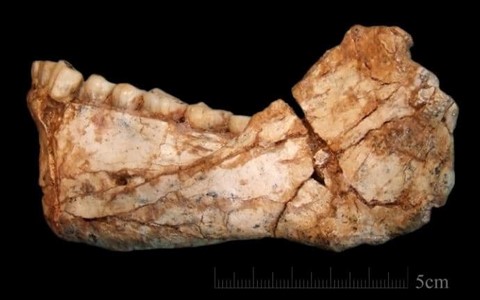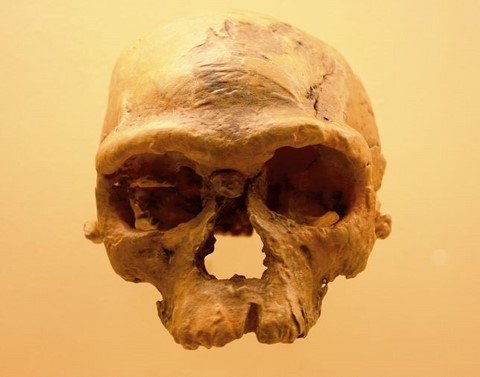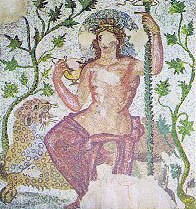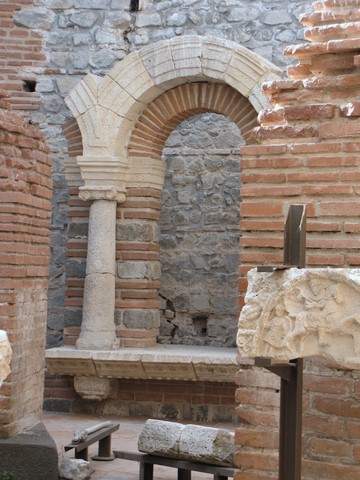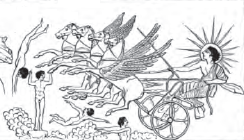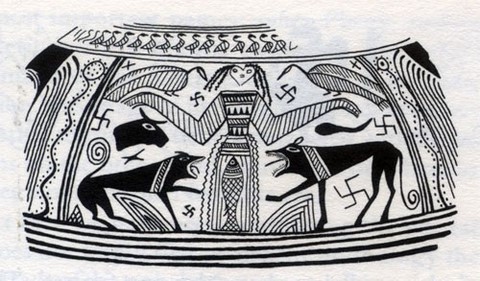2017
The latest on Chicxulub

The meteorite crashing into Yucatan which extinguished the dinosaurs and nearly snuffed out life on Earth 66 million years ago also triggered an exceptional and immediate development of microorganisms on the impact site, according to presentations at the annual meeting of the American Geophysical Union (AGU) in New Orleans.
The iron of the Bronze Age was meteoritic
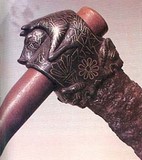
There existed objects made out of iron in the Bronze Age, before humans were able to win iron from ore... One example is the dagger of Tutankhamun, another is the blade of this ceremonial ax from Ugarit, in a heft of bronze and gold.
New: Chaos and Creation, by Alfred de Grazia
First published in India in 1981, Chaos and Creation is the first systematic attempt to put Quantavolution, then more often called neo-catastrophism, upon a firm foundation. The rapid stream of revolutionary facts and theories of natural history and human origins is channeled into a useful model for both experts and laymen. Chaos and Creation was the first book of Alfred de Grazia’s Quantavolution Series.
Zucchinis saved by music

Music can treat and even cure plants. It seems that some meticulously selected melodies have the capacity to inhibit the growth of viruses and molds and to stimulate plant growth. French physicist Joel Sternheimer uncovers the scores...
William Cocke Mullen, in memoriam(Nov. 4, 1946 - Nov. 1st, 2017)

"It's now less than an hour to midnight, when I turn 70. By a marvelous coincidence, Bard's Classics Department invited a classicist from Dartmouth (and Russian by birth), who gave a brilliant and moving lecture at 5pm today entitled: "'Not to Be Born is Best': Greek Pessimism Revisited, or: Was Nietzsche Right?" I met the lecturer just before, walked him into the lecture-room, and told him as we walked that, since I was turning 70 tomorrow (which is of course the canonical Greek for how long a man normally lives) I greatly looked forward to his lecture as an occasion for me to 'take stock' on the question of whether I should wish never to have been born! I joined ten much-loved colleagues with him for dinner afterwards at the house of a married couple who are my younger colleagues in Classics. Couldn't have been a better evening before my birthday."
Q-LIGHNING, by William C. Mullen(on the subject of Al de Grazia's T-shirt)
A talk given by Prof. William C. Mullen at the Conference of Quantavolution, 2008, in Paris.
William C. Mullen's biography
Pictures of Bill
The cataclysmic birth of gold

On August 17, astronomers in the US picked up a signal from two neutron stars crashing together 130 million years ago, when dinosaurs still roamed the Earth.
The impact, known as a ‘kilonova’ was so powerful that it shook not only space but also time, sending ripples - or gravitational waves - through the fabric of the universe.
A Germanic harbor town found at the mouth of the Elbe River
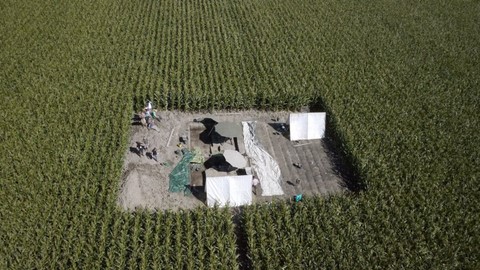
Near the mouth of the River Elbe, archaeologists have discovered a sunken settlement with a harbor. Even its name is lost. Yet it was an important center of trade in the 1st century.
JP Petit: a "pain-in-the-neck" who does not believe in Black Holes attends a conference on cosmology in Paris
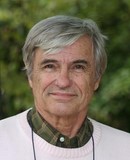
The Great Dipole Repeller
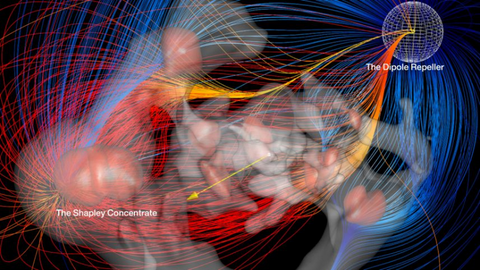
Until now, scientists assumed that a dense region of the universe is pulling us toward it, in the same way that gravity made Newton's apple fall to earth. Exciting new research shows that our galaxy is not only being pulled, but also pushed.
Earth's oxygen explained by change in the crust
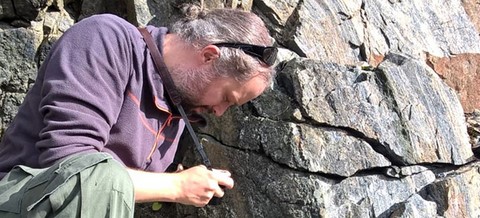
Scientists have long wondered how Earth’s atmosphere filled with oxygen. UBC geologist Matthijs Smit and research partner Klaus Mezger may have found the answer in continental rocks that are billions of years old.
“Oxygenation was waiting to happen,” said Smit. “All it may have needed was for the continents to mature.”
Gunnar Heinsohn: Slavic chronological enigmas solved - Poland's Krakow in the 1st Millennium AD
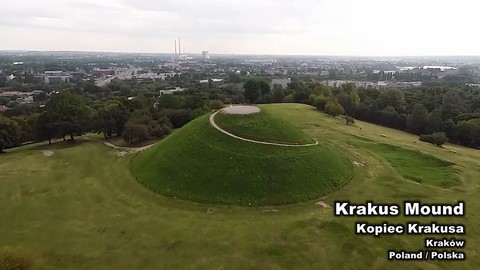
The Archaeological Museum of Kraków (Poland) is to be commended for its chronological honesty. Though its curators do not deviate from chronological dogma, they refuse to report settlement strata that cannot be found in the city’s ground. Therefore, their exhibits for the 1st millennium AD jump from the 2nd right into the 9th century AD, with nothing to show for the 700 years in between...
Buried under ashes, the newly discovered "little Pompei"
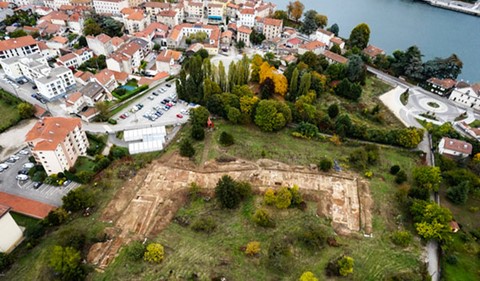
In Sainte-Colombe, near Lyon (France), 15m above the Rhône River, archaeologists have uncovered a whole suburb of ancient Roman Vienne during preventive excavation on a projected construction site. It’s an « exceptional site », « a little Pompei of Vienne », raves Benjamin Clément, the scientific leader of the operation.
Bio-advantages of the Neanderthals - (3/3)Humans in caves - Health advantages (by Amanda Laoupi)
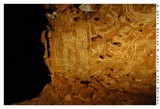
Bio-advantages of the Neanderthals - (2/3) Environmental stress factors and Neanderthal DNA (by Amanda Laoupi)

Recent genetic studies on the Neanderthal genome, composed of over 3 billion nucleotides from three individuals, conducted by an international team of researchers, indicate some form of hybridization between archaic humans and modern humans that had taken place after modern humans emerged from Africa.
Bio-advantages of the Neanderthals - (1/3) Volcanic landscapes and their positive impact on human health - by Amanda Laoupi
Environmental stimuli triggered biomechanical and biochemical alterations in the human species since the early Palaeolithic times. Our remote ancestors chose repeatedly volcanic environments, where they survived, lived, reproduced and evolved...
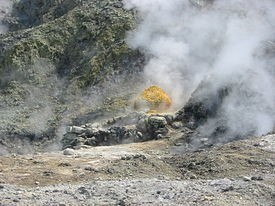
Gunnar Heinsohn: Arthur of Camelot and Aththe of Camulodunum
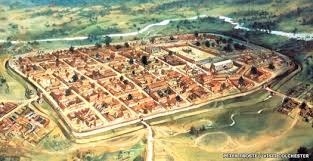
Cradle of Homo Sapiens shifted to Morocco - and 100,000 years up in time
The discovery of the bone remains of five individuals in Jebel Irhoud, near Safi, in Morocco, undisputably attributable to Homo Sapiens, show that the evolutionary processes behind his emergence involved the whole African continent and were practically complete 300,000 years ago.
Did humans split from apes in the Mediterranean?
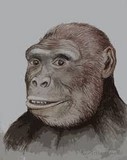
The history of human evolution is being rewritten after scientists discovered that Europe was the birthplace of mankind, not Africa.
“Our discovery outlines a new scenario for the beginning of human history,” says Professor David Begun, from the University of Toronto.
Dentistry in the Upper Palaeolithic
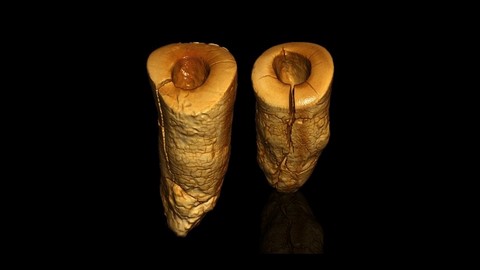
The dentist drill is not a modern invention – 13,000 years ago, an expert cleaned cavities with the help of a minute drill made out of flintstone, or bone. He also provided a filling.
Laszlo Koertvélyéssy in memoriam (1932-2017)
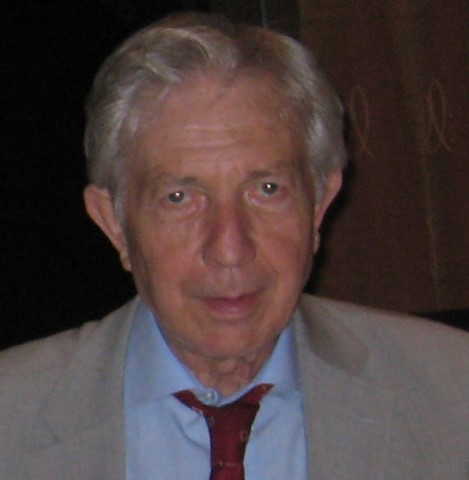
Our friend, Dr Laszlo Koertélyéssy died May 8th, in Budapest, Hungary. He wrote The Electric Universe in the 1990s.
Old African huts reassure us about the geomagnetic field

Compass needles are still pointing North, and the magnetic field is still protecting the Earth – but it is weakening. Is there a dangerous pole reversal in the offing? The floors of ancient African huts provide a clue...
Early human DNA found widely - and not in bones!

Fifty thousand years ago, a Neandertal relieved himself in a cave in present-day Belgium, depositing, among other things, a sample of his DNA. The urine clung to minerals in the soil and the feces eventually decomposed. But traces of the DNA remained, embedded in the cave floor, where earth falling from the cave’s ceiling and blowing in from outside eventually entombed it...
Meteorologists explain The Scream

It is one the world’s most famous paintings – and it exsudes a special mystery: why did Edvard Munch paint fiery waves in the background of his painting: The Scream? He may have been deeply affected by a rare atmospheric phenomenon...
What the Vulture Stone says...
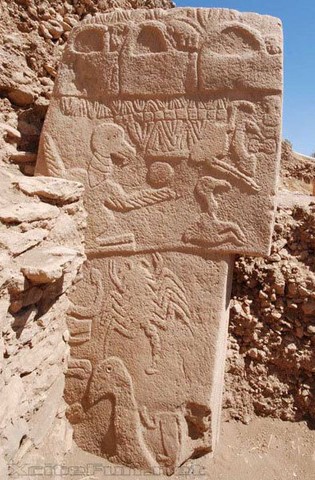
Ancient stone carvings confirm that a comet struck the Earth around 11,000BC, a devastating event which wiped out woolly mammoths and sparked the rise of civilisations. Experts at the University of Edinburgh analysed mysterious symbols carved onto stone pillars at Göbekli Tepe in southern Turkey, to find out if they could be linked to constellations. The markings suggest that a swarm of comet fragments hit Earth at the exact same time that a mini-ice age struck, changing the entire course of human history.
Major mathematical breakthrough went ignored
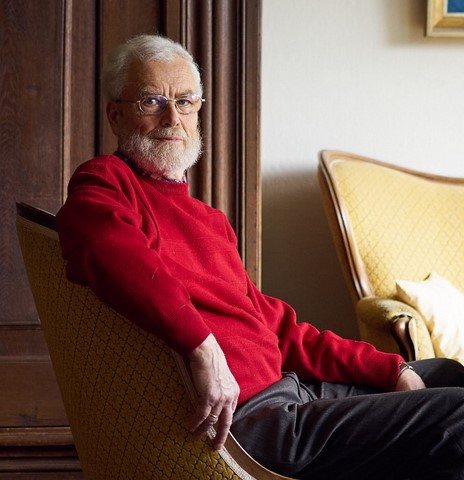
Four years into his retirement, a genial insight occurred to Thomas Royen early one morning, as he was brushing his teeth: the Gaussian Correlation Inequality could be solved with the help of some of the statistical tools he had developed when he was working in the pharmaceuticals industry. The solution to this problem had eluded mathematicians for almost sixty years, and not for want of trying...
How the Aborigenes came to Australia

The first humans probably reached Australia around 50,000 years ago, which is the age of the oldest human skeletons and tools found. But how did humans get there?
Gunnar Heinsohn: Felix Romuliana
Felix Romuliana is regarded as an ideal embodiment of a purely Late Antique (4th-6th c.) city in the Roman province of Moesia (today's Gamzigrad in Serbia), because in the earlier Imperial Antiquity of the 1st to early 3rd centuries there appears to be simply nothing at all in that splendid urban space erected around 305 CE for Emperor Galerius (293-311 CE).
Huge spike in Earth' magnetic field recorded in8th century B.C. potteries

More than 2,500 years ago in the ancient Near East, the Earth's geomagnetic field was going gangbusters. During the late eighth century B.C., a new study finds, the magnetic field that surrounds the planet was temporarily 2.5 times stronger than it is today.
Paleolithic hands
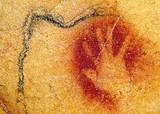
More moving almost than even the artistic representations, the imprints left by human hands on the walls of prehistoric caves create an authentic link between Paleolithic man and us...
Gunnar Heinsohn: Tenth Century Collapse
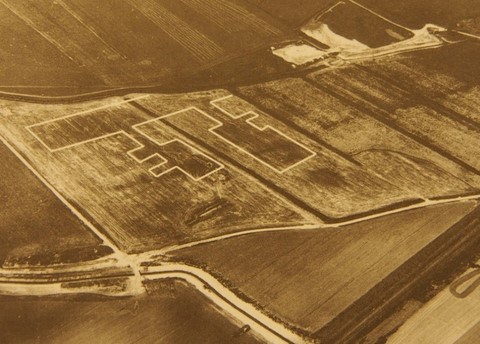
Gunnar Heinsohn: Paper-making's mysterious 700 years of secrecy
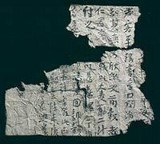
The question is why the invention of hand-made paper takes about 700 years to spread from China to east and west. In the earliest published archaeological finds, paper is dated to the 2nd c. BCE (Cotterell 2004, 11). Only about 105 AD, however, is there written information about paper making from a minister named Tsai'Lun (Cai Lun, 121 AD)...
"Boom-Star" visible in 2022
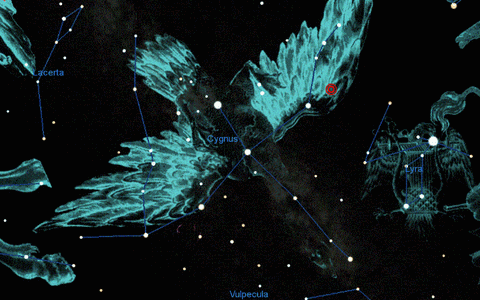
The new star, known as the Boom Star, sits just off the right hand wing of Cygnus (in red)
At the beginning of the 3rd century civil war raged in Britain as the Roman emperor Septimius Severus sought to quell unrest in the north. But unknown to the fighting cohorts and Caledonian tribes, high above their heads two stars were coming together in a huge cataclysmic explosion. Now 1800 years later the light from that collision will finally arrive on Earth creating a new star in the night sky - dubbed the ‘Boom Star - in an incredibly rare event which is usually only spotted through telescopes.
Amanda Laoupi: The Pelasgians - Sirius, Dyonisos, Apollo, Draco. More evidence (2)
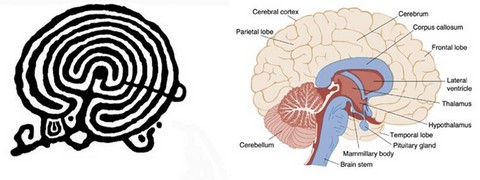
The Cygnus Hypothesis - Argo, the Ark, Argonautica, and Sirius centers of the ancient world...
Amanda Laoupi: The Pelasgians and the Sirius-Cult (1)
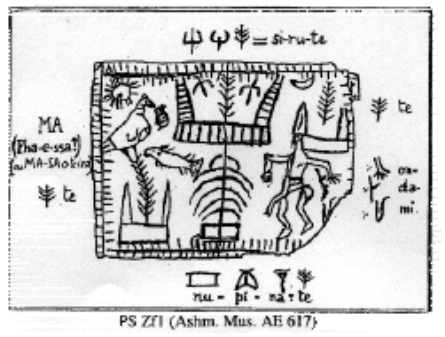
The Sirius, Moon and Venus cults came from Paleolithic Times amazingly enriched by their “journey” through the human psyche starring at the Cosmos. Especially, the Sirius cult was a pivotal cult of the Pelasgian substratum coming from Neolithic and late Paleolithic Times...
Jacques Benveniste and the "memory of water"

Jacques Benveniste (1935-2004) was a top-level French biochemist of impeccable scientific credentials. In the 1980s and 1990s he engaged in research which seemed to uncover a hitherto unknown property of water : « memory.» In 1988, he was asked by the editor-in-chief of the magazine Nature to withdraw a peer-reviewed article which had been accepted for publication. He refused, and his descent to hell began. His lost his lab and his funding. He continued his experiments in a shack on the parking lot of his former lab. He was hounded – literally – to death : he died in 2004, age 69, after a heart operation, his third. Yet, a few prominent scientists and Nobel Prize winners, such as physicist Brian Josephson, continued to take him seriously. In 2010, Luc Montagnier, Nobel Prize winner in medicine and discoverer of the HIV virus, picked up on his experiments and is presently continuing in his line of research. Luc Montagnier, now at Jiao-tong University in Shanghai, calls Benveniste "the Galileo of the XX century."



